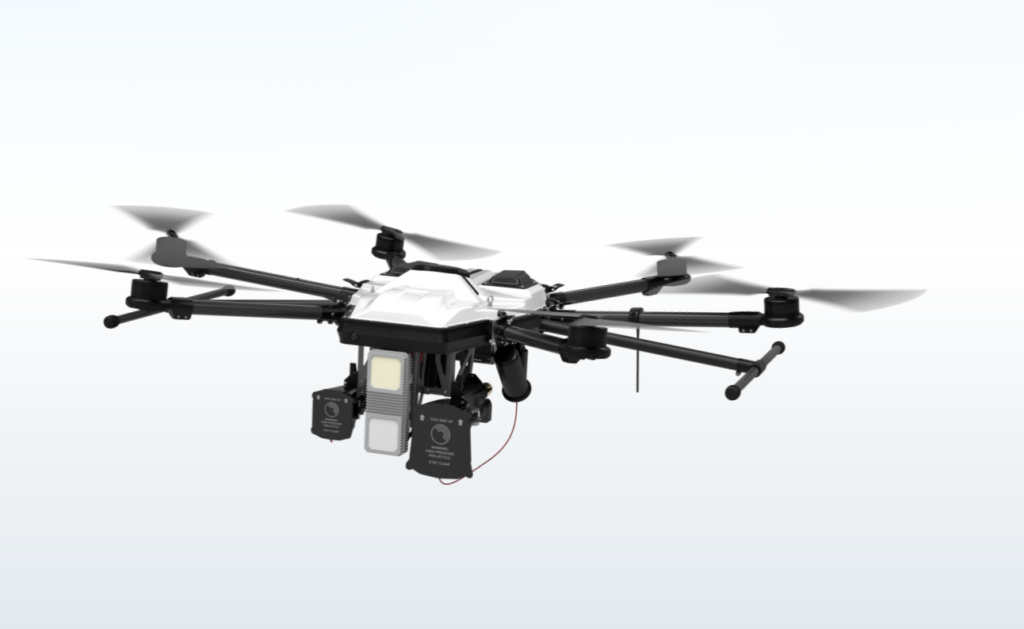
The DroneHunter F700 is a drone interceptor or counter-UAS system that is fully autonomous and radar-guided. (Photo: Fortem Technologies)
The use of uncrewed aerial systems (UAS) in defense and military operations has skyrocketed. UAS threats in battle and public spaces are continuing to rise, begging the need for continuously adapting technology to counter growing levels of sophistication. Advanced AI and radar technology can power precise drone detection and capture, and as new threats develop, counter-UAS (C-UAS) programs must provide layered and customized protection to increase accuracy and minimize or even eliminate collateral damage. Companies like Fortem Technologies are working hard to redefine the industry by developing modern solutions and strategies in C-UAS and airspace security.
An Introduction to Modern C-UAS
Advanced radar technology is the driving force behind a top-of-the-line, modern C-UAS system. The right radar technology can accurately detect threats, reduce the number of false detections of non-threatening objects and autonomously capture real ones.
All airborne objects must be detected within an assigned area, including aircraft that are not broadcasting RF, without interrupting other operations. However, the system must also be able to detect the level of threat of an object, whether it’s a bird, a plane, a drone, or Superman. These multi-tiered systems integrate radar, cued optical or thermal cameras, and RF to confirm the identification of the object and then provide threat assessment.
The key to a superior counter-UAS system is if it is reusable, precise, and cost-effective. For example, Fortem’s DroneHunter can detect a potential drone threat, determines via radar whether it is smaller or larger than itself, and captures it with nets in one of two non-self-destructive ways. If the drone is smaller, the DroneHunter tows it away. If larger, it releases a parachute and drops to the ground. This flexibility allows the system to successfully take down a range of drone threats without self-destructing, making for a reusable and accurate system.
Drone Radar to Detect Drones
Complete systems must evolve to meet and mitigate threats. Integrating with other systems can help ensure dangerous drones are effectively detected, assessed, and mitigated. Drone radar is arguably the single best choice and necessary for drone detection. Radar systems that are specifically created for drones are very different than others and require special considerations.
It’s important for drone radars to have the ability to detect small objects and reliably follow their movements. Drones are often mistaken for other things and only a drone radar can differentiate a bird or a birthday balloon from a drone. It can also identify objects regardless of environmental clutter. Areas with tall buildings or trees are nearly impossible for an average radar to comprehend. While it may be easy for a drone to navigate a cluttered course, to detect it requires specialized radar.
Altitude is another element that differentiates between regular and drone radar. Regular ground-to-air radar is incapable of picking up drones traversing low-altitude and obstacle-ridden paths, and only the most sophisticated drone radar systems can see drones regardless of altitude. Additionally, fine Doppler resolution is required and considered essential for C-UAS in order to detect drones moving as slow as one mile per hour.
Benefits of Capture vs. Destroy Method
The keys to a superior counter-UAS system are reusability, precision, and cost-effectiveness. A C-UAS program that is organized and able to capture rather than destroy contributes more to mission success than any other type of program. A C-UAS program that is required only to eliminate the drone threat will likely destroy the C-UAS itself. A system that captures its target minimizes collateral damage.
Extracting the threat, either by towing it away or dragging it down to the ground, not only removes the potential for airborne debris, protecting nearby people, buildings, or structures, but it also allows for further testing, identification, and studying of the drone threat using physical and digital forensic methods.
Reusability and cost-effectiveness go hand in hand. C-UAS programs that deploy “one-shot, one-kill” or Kamikaze-like defense mechanisms aren’t able to reuse their drone hardware. The most effective kind of program is one where more than one drone can be captured and defeated with a short relaunch time, over and over again. The DroneHunter, for example, can chase and capture multiple drones, return with the threat, get reloaded, and jump back into the sky to continue attacking. These programs don’t require the use of missiles or explosives, which expands the use case from military missions to law enforcement, airports, stadiums, and more where civilians are present.
While airborne threats continue to rise and become more sophisticated, the technology—both hardware and software—must be able to evolve to meet the needs of a strong C-UAS program.
This article is authored by Adam Robertson, CTO of Fortem Technologies.